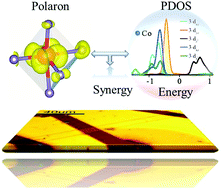The electronic properties tuned by the synergy of polaron and d-orbital in a Co–Sn co-intercalated α-MoO3 system†
Abstract
In order to realize the broadband photodetection, Co–Sn co-doped layered α-MoO3 was observed experimentally to show the excellent optoelectronic and electrical properties. In this study, first-principles calculations and Raman spectroscopy were performed to unravel the inside mechanism of the diatomic co-doped α-MoO3 system. Intriguingly, the synergy of polaron and d-orbitals was found to play an important role in tuning the electronic properties of broadband α-MoO3. Due to the large ionic radius of the Sn atom, it mainly influences the electronic properties of the co-doped system through the polaron effects, which is shown in the obvious lattice distortion after doping. Considering the fact that the transition metal Co atom has a small ionic radius, it predominantly contributes to the extended gap states of α-MoO3 by its d orbitals. When Co and Sn elements were co-doped in the system, the synergy of the polaron and d-orbital shows remarkable effects on the optoelectronic properties, light absorption, and conductivity. Furthermore, the influence of the doped sites indicating the intercalated styles and the dopant concentration was systematically investigated in our calculations. Therefore, the present work provides a fundamental understanding of the Co–Sn co-doped α-MoO3 layered materials and offers strategies for designing a more superior photodetection device.



 Please wait while we load your content...
Please wait while we load your content...